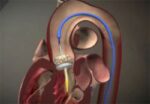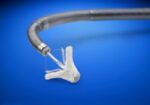Original title: Flow-Gradient Patterns in Severe Aortic Stenosis UIT Preserved Ejection Fraction. Clinical Characteristic and Predictos of Survival. Reference: Eleid, M, et al. Circulation 2013;128:1781-1789 Severe aortic stenosis is usually defined by echocardiography as a 40 mm mean transvalvular gradient Hg at >4 m/s; but there are low flow or paradoxical low flow cases with different evolution. 1704<a href="https://solaci.org/en/2013/10/22/flow-gradient-patterns-can-help-in-the-selection-of-patients-with-aortic-stenosis/" title="Read more" >...</a>
Low flow impact on outcomes following TAVI should be taken into account
Original title: Impact of Low Flow on the Outcome of High-Risk Patients Undergoing Transcatheter Aortic Valve Replacement. Reference: Florent Le Ven, et al. J Am Coll Cardiol 62;9:792-788 A study of low flow (SVi <35ml/m2) in the context of severe aortic stenosis has shown it is a predictor of worse outcomes after surgery, even though evolution with medical<a href="https://solaci.org/en/2013/08/26/low-flow-impact-on-outcomes-following-tavi-should-be-taken-into-account/" title="Read more" >...</a>
Carotid angioplasty prior to central venous catheter. The best option to solve combined problems.
Original title: A Direct Comparison of Early and Late Outcomes with Three Approaches to Carotid Revascularization and Open Heart Surgery. Reference: Mehdi H. Shishehbor et al. J Am Coll Cardiol, article in press. The prevalence of severe carotid stenosis (> 80%) in patients planning to have a Central Venous Catheter (CVC) is estimated at between 6 and<a href="https://solaci.org/en/2013/08/08/carotid-angioplasty-prior-to-central-venous-catheter-the-best-option-to-solve-combined-problems/" title="Read more" >...</a>
What is the contrast media dosing that predicts acute kidney injury after TAVI?
Original title: Renal Function-Based Contrast Dosing Predicts Acute Kidney Following Trancatheter Aortic Valve Implantation Reference: Masanori Yamamoto, et al. J Am Coll Cardiol Intv 2013;6:479–86. Acute kidney injury (AKI) presents in 10 to 30% of patients undergoing TAVI; it is associated to the increase of morbidity and mortality and it prolongues hospitalization. This study included 415 patients with<a href="https://solaci.org/en/2013/06/05/what-is-the-contrast-media-dosing-that-predicts-acute-kidney-injury-after-tavi/" title="Read more" >...</a>
QRS after TAVI, The Best Predictor for safe transitory pacemaker removal
Original title: Patients Without Prolonged QRS After TAVI with CoreValve Device do not Experience High-Degree Atrio-Ventricular Block. Reference: Gauthier Mouillet et al. Catheterization and Cardiovascular Interventions 81:882–887 (2013). High degree atrioventricular block (AVB) in the context of transcatheter aortic valve implantation (TAVI) has been reported with variable incidence (3-45%) depending on the population characteristics and the kind of<a href="https://solaci.org/en/2013/05/30/qrs-after-tavi-the-best-predictor-for-safe-transitory-pacemaker-removal/" title="Read more" >...</a>
Prosthetic endocarditis after TAVI, rare and difficult to diagnose
Original title: Prosthetic valve endocarditis after transcatheter aortic valve implantation: the incidence in a single-centre cohort and reflections on clinical, echocardiographic and prognostic features. Reference: Miriam Puls et al. EuroIntervention 2013;8:1407-1418. Prosthetic valve endocarditis is a serious complication of surgical valve replacement and occurs in 0.3 to 1.2% of patients per year. It is basically divided in early<a href="https://solaci.org/en/2013/05/15/prosthetic-endocarditis-after-tavi-rare-and-difficult-to-diagnose/" title="Read more" >...</a>
Low Gradient Severe Aortic Stenosis despite Preserved Ejection Fraction
Original title: Invasive Hemodynamic Characteristics of Low Gradient Severe Aortic Stenosis Despite Preserved Ejection Fraction. Reference: Juliane Lauten et al. J Am Coll Cardiol 2013;61:1799–808. Although the pathophysiology, clinical features, and natural course of severe aortic stenosis have been extensively described, management recommendations are still evolving. The current European and American guidelines recommend a valve area cutoff of<a href="https://solaci.org/en/2013/05/09/low-gradient-severe-aortic-stenosis-despite-preserved-ejection-fraction/" title="Read more" >...</a>
Post TAVI Hypertension is a predictor of better evolution
Original title: Post-Procedural Hypertension Following Transcatheter Aortic Valve Implantation Incidence and Clinical Significance. Reference: Gidon Y. Perlman et al. J Am Coll Cardiol Intv 2013. Article in press. Pre-procedural hypertension (HTN) is a risk factor and a predictor of increased mortality after surgical aortic valve replacement (AVR). The disappearance of the pressure gradient across the aortic valve following<a href="https://solaci.org/en/2013/05/02/post-tavi-hypertension-is-a-predictor-of-better-evolution/" title="Read more" >...</a>
Coronary Obstruction after TAVI: dreaded, but rare and solvable
Original title: Coronary Obstruction After Transcatheter Aortic Valve Implantation. A Systematic Review. Reference: Henrique Barbosa Ribeiro et al. J Am Coll Cardiol Intv 2013. Article in press. In the context of Transcatheter Aortic Valve Implantation (TAVI) there can be complications such as conduction disturbances, bleeding, residual aortic insufficiency or vascular complications, all of which have been detailed with<a href="https://solaci.org/en/2013/04/30/coronary-obstruction-after-tavi-dreaded-but-rare-and-solvable/" title="Read more" >...</a>
MitraClip® in real life
Original title: Acute outcomes after MitraClip® therapy in highly aged patients: results from the German TRAnscatheter Mitral valve Interventions (TRAMI) Registry. Reference: Wolfgang Schillinger et al. EuroIntervention 2013; 8-online publish-ahead-of-print April 2013. Recently, percutaneous repair of the mitral valve with MitraClip®, (Abbott Vascular, Santa Clara, CA, USA), has emerged as an option for patients with severe mitral regurgitation,<a href="https://solaci.org/en/2013/04/17/mitraclip-in-real-life/" title="Read more" >...</a>









